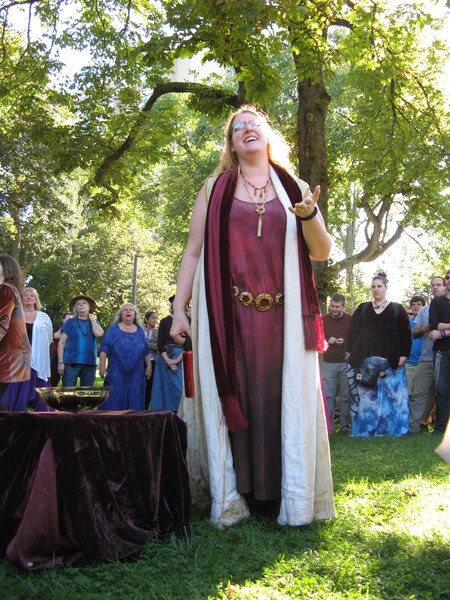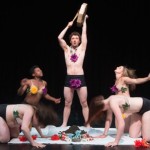I’m an amateur ritualist, at best. Most of my rituals are … well, amateurish. The ones I have written for myself work well for me, but are highly idiosyncratic. And the rituals I write for my family are probably of limited use to others, since I’m trying to do too many things at once, including (1) educating my non-Pagan children and wife about the Neo-Pagan mythos, (2) acclimating them to Neo-Pagan practice, and (3) in the words of Ruby Sara, trying to be radically engaged with all my senses, “promoting Beauty, giving thanks, celebrating the Holy Body, aspiring towards Awareness, and creating/maintaining Sacred Relationship.” Usually, the third one gets sacrificed to the first two. Plus, I think being a really good ritualist requires a certain personal quality, a charisma or authenticity, which is what I think makes a real priest or priestess. This may sound elitist to some, but I think being a good ritualist requires both skill and talent. And I know myself well enough to know I don’t have it. But I do think I can spot some of the people who do.
A few months ago, John Beckett wrote, in a post entitled “Five Ritualists at Dinner”:
“Now imagine inviting five of the best ritualists in the modern Pagan world over for dinner. You discuss ritual theory over soup, logistics and presentation over salad, the symbolism of your tradition over the main course, and your relationship with your gods over dessert. By the time you’re pouring after dinner drinks, somebody’s got a script and a red pen, somebody else is digging in their bag for a book, two people are clearing the furniture out of your living room and the last one is raiding your candle stash. …”
This got me thinking about what five ritualists I would invite to dinner. This is the first in a series in which I showcase some of the best ritualists I have met (in no particular order). I’m sure there are many more who I have not met. Share with me in the comments who you would invite to your ritualist dinner.
Shauna Aura Knight
Shauna Aura Knight is one such ritualist who has both the technique and the spiritual juice. Shauna teaches workshops on ritual and group dynamics. You may have caught her workshops at Pantheacon or ConVocation this year. If you can’t see Shauna in person, check out her YouTube video on chanting and this video of her leading a Chicago Unity Ritual. She writes a column on ritual techniques for Circle Magazine. You can read a sample article about ritual “bling” here. And here’s another article about raising ecstatic energy. She also blogs at her self-titled blog and at Pagan Activist (check out this article about the intersection of activism and ritual). She is the author of Spiritual Scents: Creative Use of Scent and Fire In Ritual and Dreamwork for the Initiate’s Path. Shauna has also contributed to A Mantle of Stars: A Devotional for the Queen of Heaven and Stepping Into Ourselves: An Anthology of Writings on Priestesses. I’ve seen Shauna described as a mystic and as a shamanic ecstatic priestess.
I was fortunate enough to attend one of Shauna’s workshops at the Chicago Pagan Pride, as well as an autumn equinox ritual she led at Ringing Anvil in Chicago, and most recently her Pantheacon workshop, “Ritual Facilitation: Raising the Sacred Fire”.
Shauna’s rituals are ecstatic. They are designed to get the Talking Self out of the way so the the Younger Self can connect with the Deep Self — in other words, using non-discursive and non-didactic means to to connect to what is most sacred within us. Ecstatic ritual is about connection: connection with the divine, connection with other people, connection with your own body and deepest Self. But mostly, ecstatic rituals are about raising energy. “Energy” has always been one of those Pagany words I have struggled with as a Humanistic Pagan. But Shauna talks about energy in a way that I can understand, less metaphysically, and more physically — like the energy that is cycled through our bodies through breathing, metabolism, and movement.
Shauna’s rituals are unscripted, but not unplanned. Shauna acts as the facilitator, not the author — she provides guidance, but also creates space for people to have their own experience. Her rituals include elements that will be familiar to many Neo-Pagans — a circle and the four “elements” — but she is not bound by any specific tradition or understanding of these elements. Her rituals are intentionally inclusive, allowing each person to conceive the divine in their own way. If you’d like to know what to expect at one of Shauna’s ritual, she has provided an outline in an article in the Winter 2009/2010 issue of Circle Magazine
I can’t do justice to Shauna’s Pantheacon workshop in this short space, but I’ll share a few notes. What I love about Shauna is that she realizes that she knows how hard it can be for someone like me to let go in ritual. Everything she does and says in ritual is designed to “help people get out of their own way.” Here’s some ways she does this:
- “Ritual bling”: Candles, fire, altars, costumes, set dressings: all these may seem superficial, but they are tools that help us forget the outside world where we’re told it’s not okay to sing or dance or express deep emotion in public. Ritual bling isn’t just about what you add to the setting, but what you take away. Anything that reminds us of the mundane world can be a distraction, from t-shirts with words or logos to ritual language that is too jargony. But too much bling can be a distraction too. Each element of the ritual, says Shauna, must support the intention of the ritual.
- Professionalism: In order feel safe enough to let go, ritual participants have to have confidence in the competence of the ritual leader. The leader needs to let the participant know that s/he knows what s/he is doing. Often that means being willing to go there first, to take the risk in letting yourself be seen.
- Numbers: Shauna says the ideal number for a private ritual is under 20. Too many more and the intimacy is lost. The ideal number for public ritual is over 50. Too few in a public ritual and the sense of anonymity is lost. Shauna uses proximity to build energy, bringing participants closer as the ritual progresses. Making people stand in lines in ritual and wait their turn to participate diffuses that energy.
- The double-bind: Non-participation is not an option in Shauna’s rituals, but you can decide how you will participate. Shauna tells participants that they can join near the center of the circle if they are comfortable, or they participate by holding space on the edge. By doing so, Shauna turns the wallflower (who can be a distraction to those closer to the center) into a participant. I found this especially helpful when I brought my wife and kids to their first ecstatic ritual. Shauna explicitly invites and validates many different forms of participation: from simple swaying to chanting or singing a tone to visualization.
- Fire: Sight, sound, smell, touch, movement: all these help transition people into a trance state. But fire is especially helpful. Shauna says that she has to work twice as hard to get a group chanting if she doesn’t have fire. I don’t know what it is about this element, but it works magic on the psyche. Maybe it’s because involves so many senses at once; fire is a sight (light), a feeling (heat), a smell, a movement, and sometimes a sound, all at the same time. Shauna recommends investing in a good cauldron for burning alcohol and Epsom salt.
- Trance questions: This is something that I really love about Shauna’s rituals. Rather than using guided visualizations, she asks participants open-ended questions. Rather than telling them what the divine looks like and feels like, she asks them to think to themselves what it looks and feels like. And then (and I found this especially helpful), she lets participants know it’s okay if they don’t know how it feels or what it looks like right now. Maybe it will come to you later. Maybe in a thought. Maybe in a dream. This takes the pressure off, and a person can just be open to the experience.
- Chanting: Shauna uses some chants (minor key) to hold space and other chants (major key) to build energy. I am chanting-impaired. At least I thought I was. But Shauna says it takes the people 7 to 10 repetitions just to get comfortable with a chant, and so she gives people time to get it. And she gives people “permission to suck.” And that is a huge relief to someone like me, for whom chanting and all the rest does not come easy.
Shauna has an active Indiegogo campaign to help her fund more Pagan leadership education. You can check it out and donate here.
















